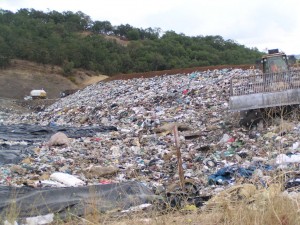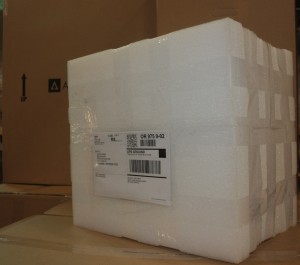Many writers, including us, seem to be switching back and forth between energy savings and carbon dioxide reduction. So what’s the deal? Is there a conversion factor between these measurements? Unfortunately, there are no hard and fast conversion factors. And that is simply because it depends upon what we’re burning and how we are turning that (typically fossil) energy into useful work.
Let’s take the case that we, as whole house fan manufacturers, and users of electricity face. Imagine a typical fossil fueled electric generating plant with a windmill in the front yard. In fact, hold the imagination, just look at the actual picture.
Per the U.S. Department of Energy studies, the average pounds of carbon dioxide per kilowatt-hour of electricity is 1.34. This is the US average. It is reasonable to use this figure even if your electricity is “clean hydropower” or “green”. If your household does not use that hydro electricity, the dam operators will not “throw away” your kilowatts. That electricity will be used to slow down another power plant – perhaps a “dirty” coal fired plant.
Let’s do the math. For example if you replace 10 of your 100 watt halogen bulbs with fluorescent bulbs, what kind of carbon dioxide reductions can you expect. In this example, the bulbs are on for an average of 4 hours per day, 365 days per year.
Pounds of CO2 saved per year = 10qty. x (100watts-15 watts)per bulb x 4 hours/day x 365 days/year x 1kwh/1,000 w-hours x 1.34 lbs-CO2/kwh = 1,663 lbs.
Not bad, but just put that into perspective, the US per capita carbon dioxide production is 46,860 lbs – so this small example would get you 3.5% towards your zero carbon goal.
For extra credit:
Nuclear plants should emit no carbon dioxide. Is that correct ?
Answer:
There are no “tailpipe” emissions from a nuclear power plant, but compared to energy conservation, you still have to take into account the CO2 embodied in the construction materials.


 So you think we can grow our own energy? My first thought was “why not”, but the inner engineer said “do the math”. OK, inner engineers always win.
So you think we can grow our own energy? My first thought was “why not”, but the inner engineer said “do the math”. OK, inner engineers always win. The vast majority of our whole house fans are shipped to the customer by UPS. Now they are a wonderful company, full of energetic 🙂 employees, who find that the best exercise is at work. Translated out of politically correct speak, it means that they throw our stuff as far as they can.
The vast majority of our whole house fans are shipped to the customer by UPS. Now they are a wonderful company, full of energetic 🙂 employees, who find that the best exercise is at work. Translated out of politically correct speak, it means that they throw our stuff as far as they can.